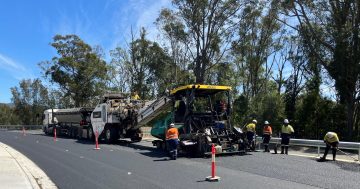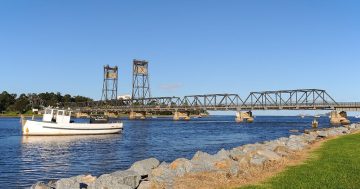
An artist’s impression of the new Batemans Bay Bridge. Image: NSW Roads and Maritime Services.
The $274 million Batemans Bay Bridge replacement project has passed the halfway mark and is on track for an early 2023 completion date. When finished, the project will give vessels with a 12-metre vertical clearance uninterrupted access under the bridge and put an end to frustrating delays for motorists currently caused by the bridge opening.
It will also provide four lanes of traffic and a three-metre wide shared path for pedestrians and cyclists.
Workers have finished producing concrete bridge segments at the pre-cast facility south of Mogo, with more than 124 already installed.
The project will soon see a start to finishing work on the northern approach to the new bridge, including the installation of traffic barriers and railings. That work is expected to continue until mid-2021.
“Once completed, the new bridge will provide safer journeys and improved connections for local communities,” a Transport for NSW spokesperson said.
“The project is supporting an average monthly workforce of around 150 workers – about half of who are local to the area.”
Work on the project will shut down for 10 days during the peak holiday season, from 24 December, 2020, until restarting on 4 January, 2021. However, workers will be on standby for any urgent matters.
Work on the new Batemans Bay Bridge began early in 2019.

Construction work continues on the new Batemans Bay bridge project. It has now passed the halfway mark. Photo: Kim Treasure.
The current steel and concrete lifting bridge was completed in 1956 at a cost of 350,000 pounds. It has been carrying traffic over the Clyde River ever since.
However, it is narrow and prone to creating bottlenecks, with the main issue being that twice a day, when the ferry comes through, the bridge opens and traffic grinds to a halt for about 10 minutes.
That’s on a good day when the ‘vertical lift’ bridge doesn’t become stuck in the up position, requiring action from emergency services.
Prior to 1956, the only way across Clyde River was by ferry, which could only take 28 cars every 15 minutes.
The Kings Highway and Princes Highway roundabouts at the Canberra-side entrance to Batemans Bay are now fully open. Traffic lights are a new addition to keep traffic flowing during peak times.
















